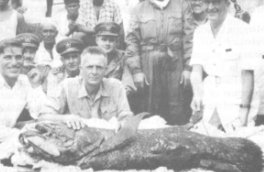
2nd Coelacanth Ever Caught


Looking into the mouth of an enormous female, caught June, 1989
Discovery of the Indonesian Coelacanths
Forty six years after the "discovery" of coelacanths in the Comoro Islands, a new population has been identified (1998) by at least two specimens caught off of North Sulawesi, Indonesia (And two others filmmed in 1999). Post doctoral research fellow, Dr. Mark Erdmann was on a honeymoon trip to the area in September, 1997, investigating a coral reef research site, when his wife, Arnaz, spotted a strange fish being wheeled into the fish market. They recognized the fish as a coelacanth and snapped a picture of it before it was sold. Believing the fish to be already known from Indonesia, the two later posted the picture on their honeymoon website, when Dr. E.K. Balon of the University of Guelph, a longtime coelacanth specialist, advised Mark to withdraw the picture and pursue further funding to confirm a second specimen.
The National Geographic Society, Nature, and the Smithsonian Institute jumped on the bandwagon decreeing a news embargo which kept the coelacanth research community in the dark for another year. On July 30th, 1998 a second specimen was brought live to Dr. Erdmann. An attempt was made to keep the fish alive by dragging it through the water. This effort failed, however, this second specimen confirmed the find and led to the press release of September 24th, 1998, and subsequent world wide attention.
North Sulawesi is some 10,000 kilometers from the Comoros with no apparent water current interactions. This population would appear to be completely isolated from the Comoran coelacanths whereas recent catches off of Madagascar and East Africa have not been eliminated as possible strays or satellite colonies. The Indonesian fishermen had long called their coelacanth "Rajah Laut" (King of the Sea). The observed specimens appear identical to the Comoran coelacanth, Latimeria chalumnae, except that they are brown rather than blue and evince gold flecks on their sides. DNA comparisons were performed and appear to confirm a new species of coelacanth which has been named Latimeria menadoensis. The Indonesian authorities have declared their willingness to cooperate with several conservation iniatives, however, futher bycatches will be kept for research.